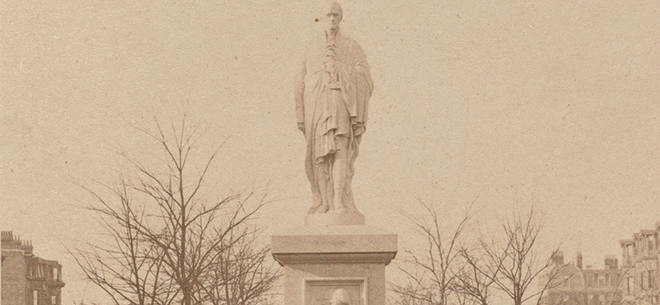
With the immensely popular, critically acclaimed musical Hamilton making its Boston debut beginning September 18, now is the perfect time to examine the life of our nation’s first Secretary of the Treasury, Alexander Hamilton. Although New York may have more of a connection to this key figure to the formative years of the United States, the Hub can also make a small, yet important, claim on this Founding Father who has been thrust into the spotlight thanks to Lin-Manuel Miranda’s ground-breaking masterpiece.
Born on the island of Nevis, a part of the British West Indies, in about 1757, Hamilton later moved to St. Croix of the Virgin Islands, where he was orphaned after his mother’s death in 1768. Finding work as a clerk, the young man had grander ambitions, and eventually found his way to England’s North American colonies seeking an education.
This is where the local connection enters the picture. Emigrating from St. Croix, Hamilton first landed in what would eventually become the United States in 1772 at the port of Boston, not far from Faneuil Hall, which, in those days, sat on the town’s waterfront. Faneuil Hall had been the site of many tax protests, and although Hamilton passed through the area in the relatively quiet period between the Boston Massacre and the Boston Tea Party, a revolutionary fervor no doubt still persisted that purportedly had a great influence on the patriot-to-be.
From Beantown, Hamilton proceeded quickly to New York City, where he soon entered studies at King’s College, the precursor to Columbia University. The rest, as they say, is history: while still a student, he spoke publicly (and also wrote anonymously) in defense of the colonists’ cause against the British, and later, after the Battle of Lexington and Concord, joined the war effort, eventually rising to the level of chief staff aide to George Washington himself. When the war ended, Hamilton became a key advocate for the United States Constitution, and was a founder of the Federalist Party as well as the first Secretary of the Treasury under Washington, a role in which he laid the foundations for America’s financial system. All these accomplishments didn’t save Hamilton from an ignominious end, however, when, on July 11, 1804, he was mortally wounded in a duel with then-Vice President Aaron Burr, a bitter political rival of whom Hamilton had been sharply critical.
Today, Hamilton’s connection to this area extends beyond the musical set to dazzle Boston’s Theatre District. His influence was such that a town on Boston’s North Shore was named after him in 1793. Former Massachusetts governor Alexander Hamilton Bullock, who served from 1866–69, also bore his name. And for those who want to stand in Hamilton’s virtual presence, two pieces of art depicting his likeness crafted by prominent artists—an 1806 oil portrait by John Trumbull on display at the Museum of Fine Arts and a statue crafted by William Rimmer erected on the Commonwealth Avenue Mall in 1865 (pictured above)—reside in the city.


